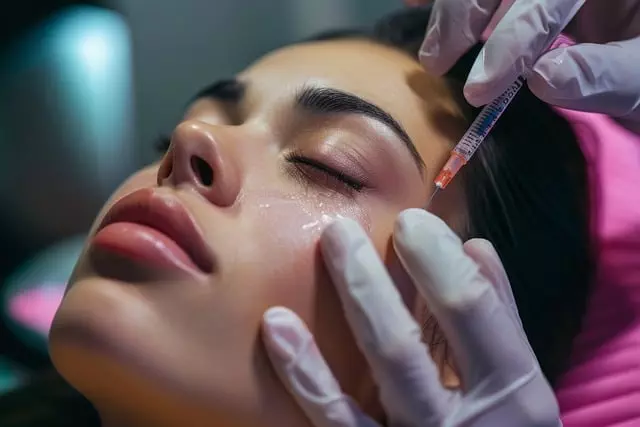Botox for facial contouring, particularly targeting the jawline, is a popular non-surgical procedure. By relaxing masseter muscles with botulinum toxin (botox), it temporarily paralyzes them to create a slimmer, more defined jawline, visible within 2-4 days. This outpatient treatment, lasting 15-30 minutes, has minimal side effects and results last 3-6 months. Ideal candidates have mild to moderate muscle tone along the jawline, while those with bleeding disorders or certain medical conditions may not be suitable. Aftercare includes rest, gentle cleaning, cold compresses, a soft diet, and staying hydrated. Regular top-ups every 3-6 months maintain results, with professional guidance crucial for personalized care.
“Uncover the secrets of safe and effective jawline shaping with Botox, a non-invasive procedure revolutionizing facial contouring. This comprehensive guide delves into the science behind Botox’s ability to define jawlines, offering a natural enhancement. We explore benefits, ideal candidate selection, step-by-step procedures, and potential risks. Learn about recovery, aftercare, and long-term maintenance for optimal results. Discover why Botox for facial contouring is a popular choice for those seeking subtle yet powerful jawline definition.”
Understanding Botox for Jawline Shaping: A Non-Invasive Approach to Facial Contouring

Botox for facial contouring, specifically targeting the jawline, has emerged as a popular non-invasive aesthetic procedure. This technique leverages the muscle-paralyzing properties of botulinum toxin (botox) to relax the masseter muscles, which are responsible for chewing and can contribute to a square or angular jawline appearance. By temporarily paralyzing these muscles, Botox can create a slimmer, more defined jawline, enhancing facial balance and symmetry.
The procedure is relatively quick and often performed in an outpatient setting. A skilled provider will carefully inject small amounts of Botox into specific areas of the jaw, ensuring precision and minimizing discomfort. Results typically become visible within 2-4 days as muscle activity decreases, leading to a more refined jawline contour that can last for several months. This non-surgical approach offers individuals a temporary yet effective solution for achieving their desired facial shape without the risks and recovery associated with traditional surgery.
The Science Behind Botox: How It Works for Jawline Definition

Botox, a protein derived from bacteria, has become a popular non-surgical option for facial contouring, particularly when it comes to defining the jawline. Its mechanism of action involves blocking nerve signals that trigger muscle contraction, leading to temporary relaxation and reduced volume in targeted areas. In the context of Botox for facial contouring, this process helps to reshape facial features, especially along the jawline, cheekbones, and brow bone.
When used for jawline shaping, Botox is injected into specific muscles responsible for chewing and facial expressions. This strategic injection disrupts the muscle’s ability to contract, resulting in a slimmer appearance of the jawline and cheeks. Over time, as the effects of Botox wear off (typically lasting 3-6 months), the relaxed muscles prevent the body from regaining the previous volume, creating a more defined and sculpted jawline—a sought-after aesthetic effect for many individuals considering facial contouring procedures.
Benefits of Using Botox for Jawline Enhancement: What to Expect

Using Botox for jawline shaping offers several benefits as a non-surgical facial contouring procedure. It’s a popular choice for those looking to achieve a more defined and sculpted look without invasive surgery. By injecting small amounts of botulinum toxin into specific muscles, it relaxes them, reducing the ability to contract and thereby smoothing out uneven skin and defining facial features. This results in a more balanced jawline and cheekbones, enhancing overall facial structure.
When considering Botox for facial contouring, patients can expect noticeable results within 2-4 days after treatment, with the full effect visible after about a week. The procedure itself is relatively quick, usually taking around 15-30 minutes, and is often performed in an outpatient setting. While there may be some temporary side effects like mild swelling or bruising, these generally subside within a few days. It’s essential to consult with a qualified medical professional who can assess your specific needs and provide personalized guidance for optimal results.
Candidate Selection: Who is a Good Fit for Botox Jawline Contouring?

When considering Botox for jawline shaping, or facial contouring as it’s also known, understanding who is a good candidate is essential. This non-surgical procedure is ideal for individuals seeking to enhance their facial structure and reduce the appearance of a square or angular jawline. The ideal candidate is typically someone with mild to moderate muscle tone along the jawline and jowls, as Botox works best on areas with active muscular movement.
It’s important to note that this treatment is not recommended for everyone. People with certain medical conditions, such as bleeding disorders or those currently taking blood-thinning medications, should avoid Botox. Additionally, individuals with a history of severe allergies or those pregnant or breastfeeding may not be suitable candidates. A consultation with a qualified healthcare provider specializing in injectables is crucial to determine if Botox for facial contouring aligns with your specific needs and goals.
Procedure Overview: Step-by-Step Guide to Safe Botox Application

The procedure of using Botox for jawline shaping, or facial contouring, involves a precise and strategic injection technique to achieve desired results. It’s a non-surgical approach that temporarily relaxes specific muscle groups, leading to a slimmer and more defined jawline. The process begins with a thorough consultation where the dermatologist assesses your medical history and determines if Botox is suitable for you. During the actual procedure, a small amount of Botox is injected into key areas along the jawline using fine needles. This targets muscles responsible for excess tension and contouring.
A step-by-step guide to safe application includes: cleaning and preparing the skin, identifying target muscle groups, injecting Botox in calculated doses, and finally, applying a cold compress to minimize any potential swelling or discomfort. It’s crucial that this procedure is performed by a licensed professional who understands facial anatomy to ensure safety and effective results.
Potential Side Effects and Risks: Being Informed About the Process

When considering botox for facial contouring, particularly for jawline shaping, it’s crucial to be aware of potential side effects and risks. While Botox is generally safe when administered by a qualified healthcare professional, there can still be temporary complications like bruising, swelling, or headaches post-treatment. These usually subside within a few days. More seriously, botox can cause muscle weakness in the treated area, which may impact facial expressions, particularly if it affects the masseter muscles responsible for chewing.
It’s essential to have an open and honest discussion with your doctor about these risks and benefits before proceeding with any botox for facial contouring procedures. They should provide detailed information on what to expect during and after treatment, and how to manage any adverse effects. This informed consent process is a vital step in ensuring a safe and effective experience with Botox for jawline shaping.
Recovery and Aftercare: Tips for Optimizing Results

After your Botox for facial contouring procedure, it’s crucial to follow proper aftercare tips to optimize results and ensure a smooth recovery. Firstly, rest is vital; allow yourself time to relax and avoid strenuous activities for at least 24 hours following the treatment. Secondly, keep the treated area clean and dry; gently cleanse with a mild cleanser and moisturize as needed, but avoid using any harsh products or making excessive movements that could irritate the skin.
Additionally, it’s important to apply cold compresses to reduce swelling and discomfort. You can do this for 10-15 minutes at a time, several times a day. Be mindful of your diet; stick to soft, cool foods for the first few days to prevent any irritation or strain on the treated area. Stay hydrated by drinking plenty of water, which will aid in the healing process and help maintain skin hydration. Remember that every individual’s recovery may vary, so it’s advisable to consult with your healthcare provider for personalized advice and to address any concerns promptly.
Long-Term Maintenance: Ensuring Lasting Facial Contour

Botox for facial contouring, particularly on the jawline, has become a sought-after non-surgical procedure for those aiming to achieve a more defined look. While the initial results can be impressive, maintaining these contours over time is essential to achieving long-lasting satisfaction. Regular top-ups are often required to sustain the desired facial shape, with treatments typically every 3-6 months. This maintenance schedule ensures that the effects of Botox remain optimal, providing a natural and subtle enhancement without sacrificing comfort or appearance.
The longevity of results varies depending on individual factors such as muscle activity and skin type, but with consistent care, patients can enjoy the benefits of enhanced jawline definition for extended periods. Professional guidance from experienced practitioners is vital to determine the ideal maintenance plan, ensuring that Botox applications remain safe, effective, and tailored to each patient’s unique needs.
